1997 BUICK CENTURY mirror
[x] Cancel search: mirrorPage 201 of 406
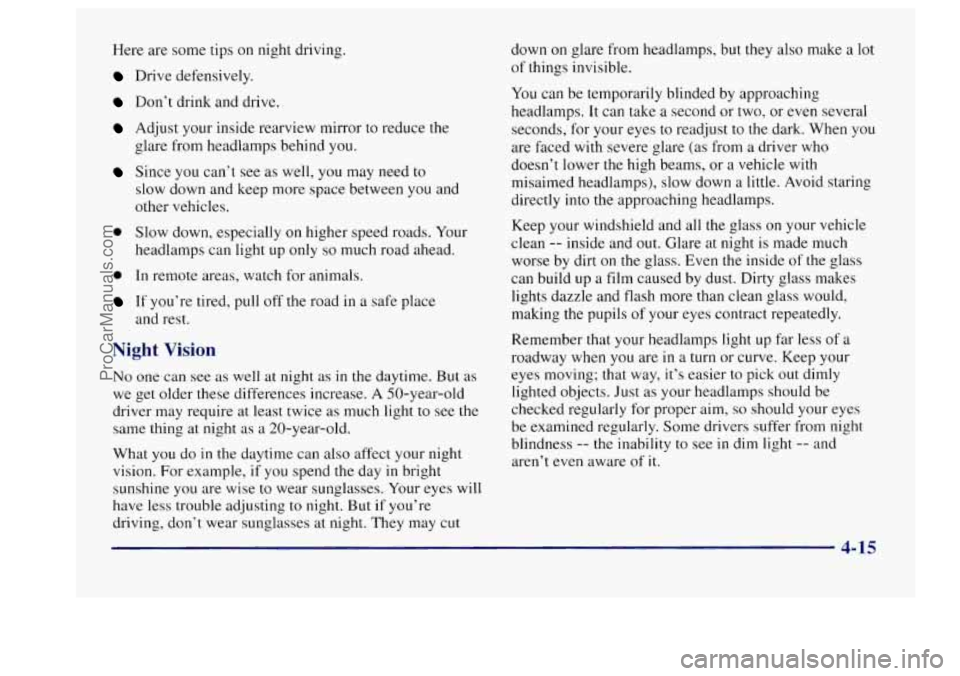
Here are some tips on night driving.
Drive defensively.
Don’t drink and drive.
Adjust your inside rearview mirror to reduce the
glare from headlamps behind
you.
Since you can’t see as well, you may need to
slow down and keep more space between you and
other vehicles. down on
glare from headlamps, but they
also make a lot
of things invisible.
You can be temporarily blinded by approaching
headlamps.
It can take a second or two, or even several
seconds,
for your eyes to readjust to the dark. When you
are faced with severe glare
(as from a driver who
doesn’t lower the high beams, or a vehicle with
misaimed headlamps), slow down a little. Avoid staring
directly into the approaching headlamps.
0 Slow down, especially on higher speea roads. Your
headlamps can light
up only so much road ahead.
0 In remote areas, watch for animals.
If you’re tired, pull off the road in a safe place
and rest.
Night Vision
No one can see as well at night as in the daytime. But as
we get older these differences increase.
A 50-year-old
driver may require at least twice
as much light to see the
same thing at night as a 20-year-old.
What you do
in the daytime can also affect your night
vision. For example,
if you spend the day in bright
sunshine you are wise to wear sunglasses. Your eyes will
have less trouble adjusting to night. But if you’re
driving, don’t wear sunglasses at night. They may cut Keep your windshield and all the glass
on your vehicle
clean
-- inside and out. Glare at night is made much
worse by dirt
on the glass. Even the inside of the glass
can build up
a film caused by dust. Dirty glass makes
lights dazzle and flash more than clean glass would,
making the pupils of your eyes contract repeatedly.
Remember that your headlamps light up far less of
a
roadway when you are in a turn or curve. Keep your
eyes moving; that way, it’s easier
to pick out dimly
lighted objects. Just as your headlamps should be
checked regularly for proper aim,
so should your eyes
be examined regularly. Some drivers suffer from night
blindness
-- the inability to see in dim light -- and
aren’t even aware
of it.
4- 15
ProCarManuals.com
Page 206 of 406
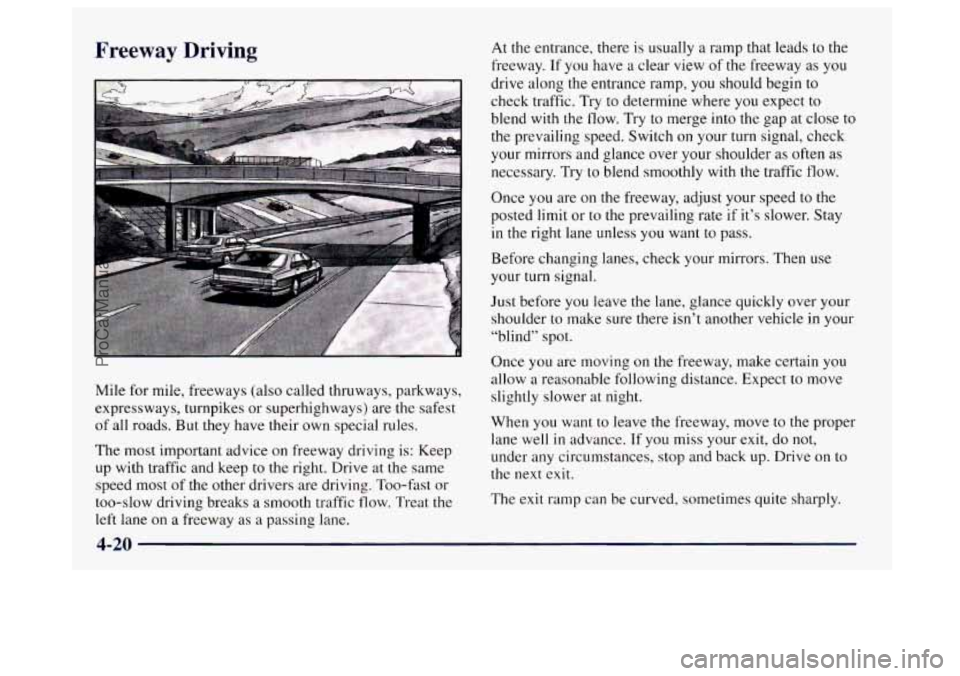
Freeway Driving
Mile for mile, freeways (also called thruways, parkways,
expressways, turnpikes or superhighways) are the safest
of all roads. But they have their own special rules.
The most important advice
on freeway driving is: Keep
up with traffic and keep to
the right. Drive at the same
speed most of the other drivers are driving.
Too-fast or
too-slow driving breaks a smooth traffic flow. Treat the
left lane on a freeway
as a passing lane.
At the entrance, there is usually a ramp that leads to the
freeway.
If you have a clear view of the freeway as you
drive along the entrance ramp, you should begin to
check traffic. Try to determine where you expect to
blend with the flow. Try
to merge into the gap at close to
the prevailing speed. Switch on your turn signal, check
your mirrors and glance over your shoulder
as often as
necessary. Try
to blend smoothly with the traffic flow.
Once you are on the freeway, adjust your speed to
the
posted limit or to the prevailing rate if it’s slower. Stay
in the right lane unless you want to pass.
Before changing lanes, check your mirrors. Then use
your turn signal.
Just before you leave the lane, glance quickly over your
shoulder to make sure there isn’t another vehicle in your
“blind” spot.
Once you are moving on the freeway, make certain you
allow a reasonable following distance. Expect to move
slightly slower at night.
When you want
to leave the freeway, move to the proper
lane
well in advance. If you miss your exit, do not,
under any circumstances, stop and back
up. Drive on to
the next exit.
The exit ramp can be curved, sometimes quite sharply.
ProCarManuals.com
Page 208 of 406
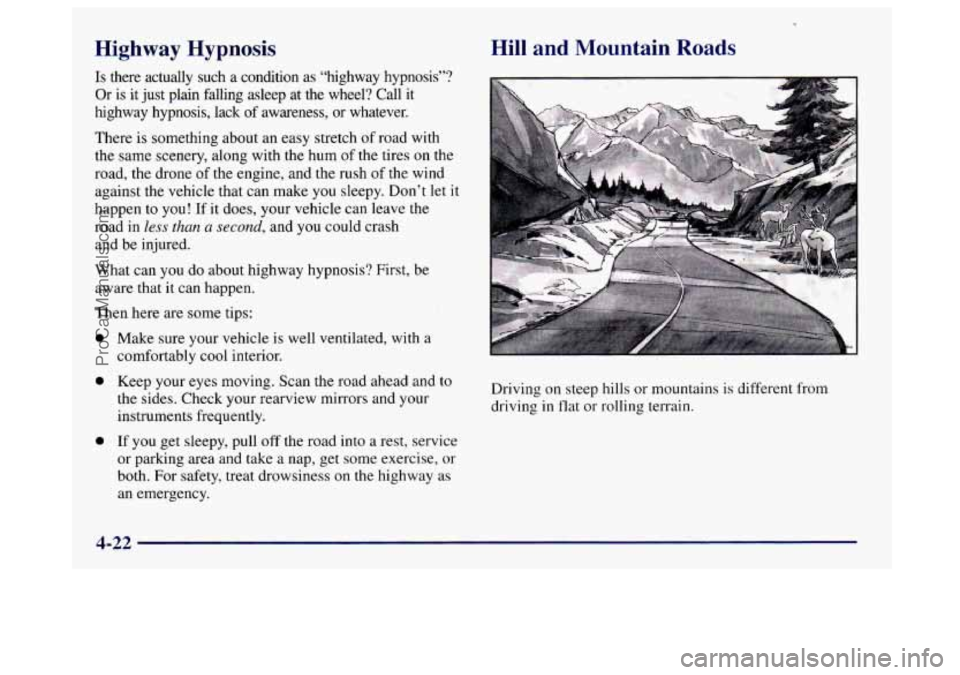
Highway Hypnosis
Is there actually such a condition as “highway hypnosis”?
Or is it just plain falling asleep at the wheel? Call it
highway hypnosis, lack
of awareness, or whatever.
There is something about an easy stretch of road with
the same scenery, along with the hum
of the tires on the
road, the drone
of the engine, and the rush of the wind
against the vehicle that can make
you sleepy. Don’t let it
happen
to you! If it does, your vehicle can leave the
road in less than a second, and you could crash
and be injured.
What can
you do about highway hypnosis? First, be
aware that it can happen.
Then here are some tips:
0
0
0
Make sure your vehicle is well ventilated, with a
comfortably cool interior.
Keep your eyes moving. Scan the road ahead and to
the sides. Check your rearview mirrors and your instruments frequently.
If
you get sleepy, pull off the road into a rest, service
or parking area and take a nap, get some exercise, or
both. For safety, treat drowsiness on the highway as
an emergency.
Hill and Mountain Roads
-
Driving on steep hills or mountains is different from
driving
in flat or rolling terrain.
4-22
ProCarManuals.com
Page 220 of 406
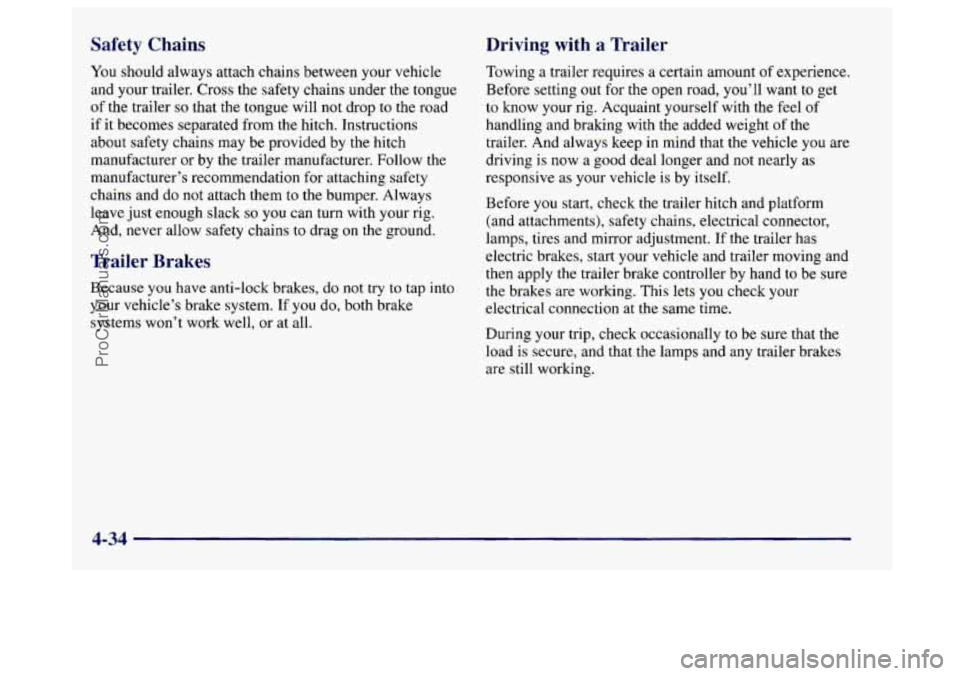
Safety Ch: - Driving with a Trailer
Towing a trailer requires a certain amount of experience.
Before setting out for the open road, you’ll want to get
to know your rig. Acquaint yourself with the feel of
handling and braking with the added weight of the
trailer. And always keep in mind that the vehicle you are
driving is now a good deal longer and not nearly as
responsive as your vehicle is by itself.
You should always attach chains between your vehicle
and your trailer. Cross the safety chains under the tongue
of the trailer
so that the tongue will not drop to the road
if it becomes separated from the hitch. Instructions
about safety chains may be provided by
the hitch
manufacturer or by the trailer manufacturer. Follow the
manufacturer’s recommendation for attaching safety
chains and do not attach them
to the bumper. Always
leave just enough slack
so you can turn with your rig.
And, never allow safety chains to drag on the ground.
Trailer Brakes
Because you have anti-lock brakes, do not try to tap into
your vehicle’s brake system. If you do, both brake
systems won’t work well, or at all. Before
you start, check the trailer hitch and platform
(and attachments), safety chains, electrical connector,
lamps, tires and mirror adjustment. If the trailer has
electric brakes, start your vehicle and trailer moving and then apply the trailer brake controller by hand to be sure
the brakes are working. This lets you check your
electrical connection at the same time.
During your trip, check occasionally to be sure that the
load is secure, and that the lamps and any trailer brakes
are
still working.
4-34
ProCarManuals.com
Page 324 of 406
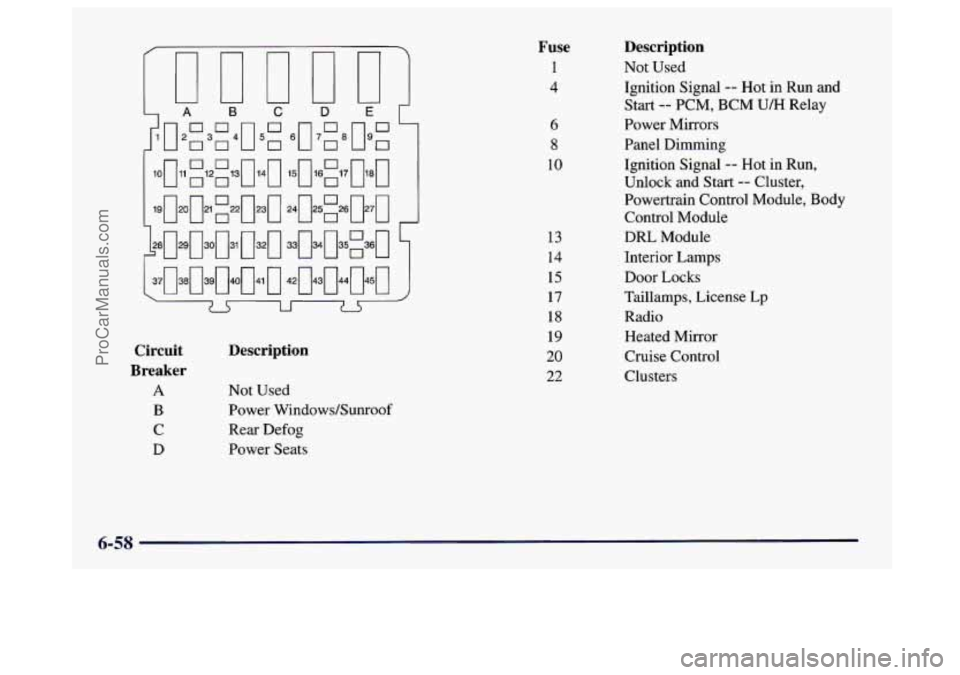
Circuit
Breaker
A
B
C
D
Description
Not Used
Power Windows/Sunroof
Rear Defog
Power Seats
Fuse
1
4
6
8
10
13
14
15
17
18
19
20
22
Description
Not Used
Ignition Signal
-- Hot in Run and
Start
-- PCM, BCM U/H Relay
Power Mirrors
Panel Dimming
Ignition Signal
-- Hot in Run,
Unlock and Start -- Cluster,
Powertrain Control Module, Body
Control Module
DRL Module
Interior Lamps
Door Locks
Taillamps, License Lp
Radio Heated Mirror
Cruise Control
Clusters
6-58
ProCarManuals.com
Page 326 of 406
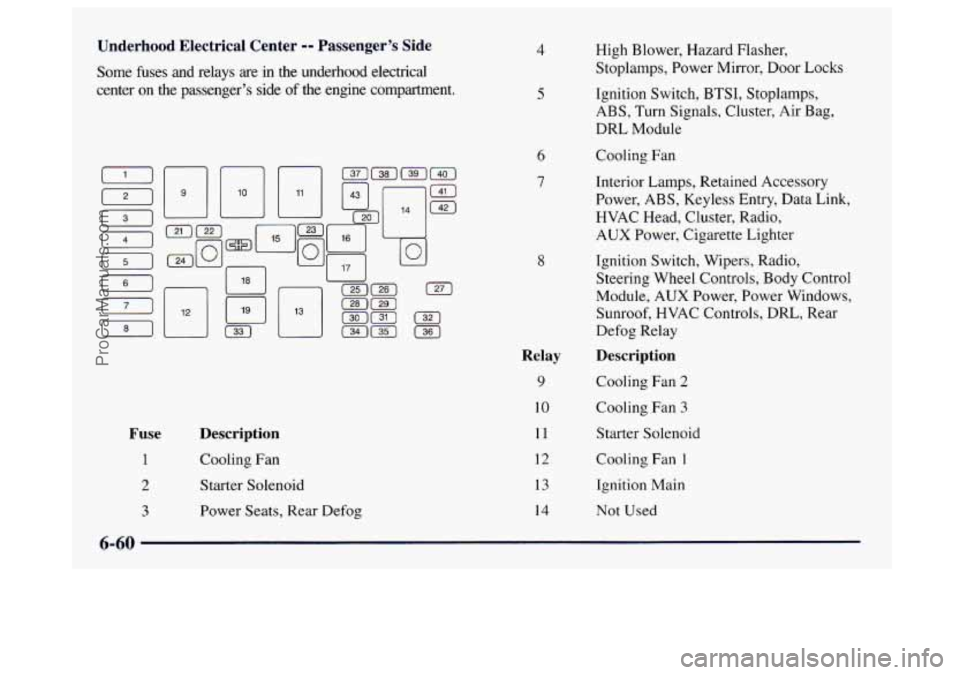
Underhood Electrical Center -- Passenger's Side
Some fuses and relays are in the underhood electrical
center on the passenger's side
of the engine compartment.
D
121
(31
(41
(51 F I I I I
m
[61
18j
(71 [TI
Fuse
1
2
3
Description
Cooling Fan
Starter Solenoid
Power Seats, Rear Defog
4
5
6
7
8
Relay
9
10
11
12
13
14
High Blower, Hazard Flasher,
Stoplamps, Power Mirror, Door Locks
Ignition Switch, BTSI, Stoplamps,
ABS, Turn Signals, Cluster, Air Bag,
DRL Module
Cooling Fan
Interior Lamps, Retained Accessory
Power, ABS, Keyless Entry, Data Link,
HVAC Head, Cluster, Radio,
AUX Power, Cigarette Lighter
Ignition Switch, Wipers, Radio,
Steering Wheel Controls, Body Control
Module, AUX Power, Power Windows,
Sunroof, HVAC Controls, DRL, Rear
Defog Relay
Description
Cooling Fan 2
Cooling Fan 3
Starter Solenoid
Cooling Fan
1
Ignition Main
Not Used
ProCarManuals.com
Page 395 of 406
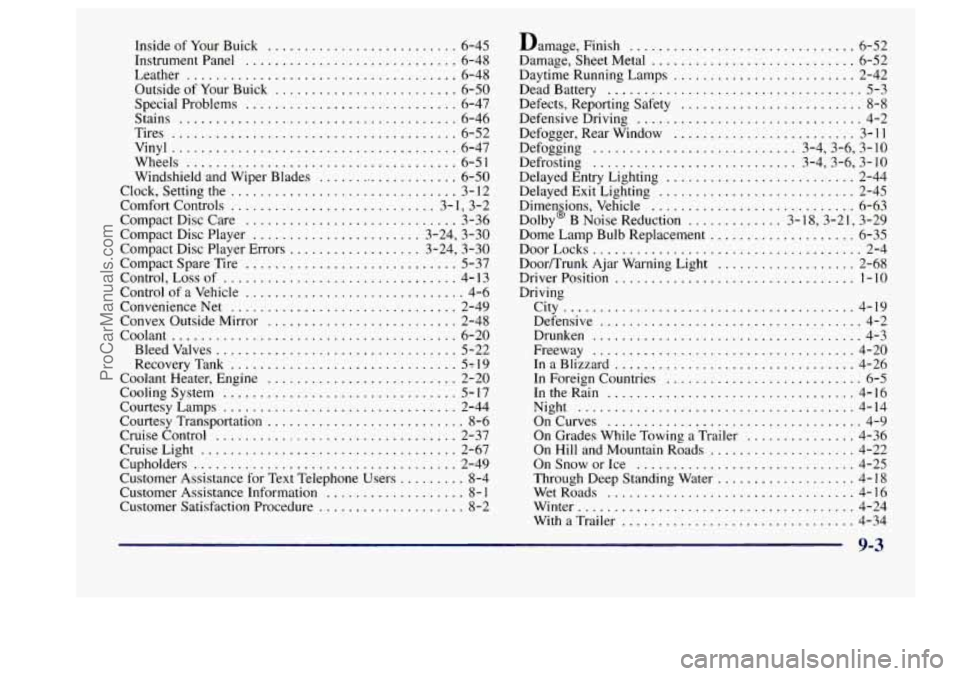
Inside of Your Buick .......................... 6-45
Instrument Panel
............................. 6-48
Leather
..................................... 6-48
Outside of Your Buick
......................... 6-50
Special Problems
............................. 6-47
Stains
...................................... 6-46
Tires
....................................... 6-52
Vinyl ....................................... 6-47
Wheels
..................................... 6-51
Windshield and Wiper Blades
.................... 6-50
Clock. Setting the
............................... 3- 12
Comfort Controls
............................ 3- 1. 3.2
Compact Disc Care ............................. 3-36
Compact Disc Player
....................... 3.24. 3.30
Compact Disc Player Errors .................. 3.24. 3.30
Control. Lossof
................................ 4-13
Control
of a Vehicle .............................. 4-6
Convenience
Net ............................... 2-49
Convex Outside Mirror
.......................... 2-48
Coolant
....................................... 6-20
Bleedvalves
................................. 5-22
RecoveryTank
............................... 5719
Coolant Heater. Engine
.......................... 2-20
Cooling System
................................ 5-17
Courtesy Lamps
................................ 2-44
Courtesy Transportation
........................... 8-6
Cruise Control
................................. 2-37
Cruise Light
................................... 2-67
Compact Spare
Tire
............................. 5-37
Cupholders
.................................... 2-49
Customer Assistance for Text Telephone Users
......... 8-4
Customer Assistance Information
................... 8- 1
Customer Satisfaction Procedure .................... 8-2 Damage.
Finish
............................... 6-52
Damage. Sheet Metal
............................ 6-52
Daytime Running Lamps
......................... 2-42
Dead Battery
................................... 5-3
Defects. Reporting Safety
......................... 8-8
Defensive Driving
............................... 4-2
Defogger. Rear Window
......................... 3-11
Defogging ............................ 3-4.3.6. 3- 10
Defrosting ............................ 3.4.3.6. 3.10
Delayed Exit Lighting ........................... 2-45
Dimensions. Vehicle
............................ 6-63
Dolby@
B Noise Reduction ............. 3.18.3.21. 3.29
Dome Lamp Bulb Replacement
.................... 6-35
DoorLocks ..................................... 2-4
Door/Trunk Ajar Warning Light
................... 2-68
Driver Position
................................. 1 . IO
Driving
City
........................................ 4-19
Defensive
.................................... 4-2
Drunken
..................................... 4-3
Freeway
.................................... 4-20
InaBlizzard
................................. 4-26
In Foreign Countries
........................... 6-5
IntheRain
.................................. 4-16
Night
...................................... 4-14
OnCurves
................................... 4-9
On Grades While Towing
a Trailer ............... 4-36
On Hill and Mountain Roads
.................... 4-22
On Snow or Ice
.............................. 4-25
WetRoads
.................................. 4-16
Winter
...................................... 4-24
With
a Trailer ................................ 4-34
Delayed Entry Lighting
.......................... 2-44
Through Deep Standing Water
................... 4-18
9-3
ProCarManuals.com
Page 396 of 406

Drunken Driving ................................ 4-3 Fabric Cleaning ............................. 6-46
Dual Automatic ComforTemp Climate Control
......... 3-7 Features and Controls ............................ 2-1
Dual ComforTemp Climate Control .................. 3-4 Filling Your Tank ................................ 6-5
Filter.Air
..................................... 6-15
Electrical Equipment. Adding
..... 2.20. 2-5 1. 3-35: 6-56
Electrical Equipment. Adding
........... 2-20. 3.35. 6-55
Electrical System
............................... 6-56
Electrochromic Daymight Rearview Mirror
.......... 2-47
Engine
........................................ 6-9
Coolant
..................................... 6-20
Coolant Heater
............................... 2-20
Coolant Level Check
.......................... 7-37
Coolant Temperature Gage
..................... 2-60
Coolant Temperature Light
..................... 2-60
Exhaust
..................................... 2-30
Identification
................................ 6-55
OilLevelCheck
.............................. 7-37
Overheating
................................. 5-15
Running While Parked
......................... 2-3 1
Specifications ................................ 6-63
Starting Your
................................ 2- I9
Engine011
.................................... 6-10
Adding
..................................... 6-11
Additives
................................... 6-13
Checking ................................... 6-11
Used
....................................... 6-14
What Kind to Use
............................. 6- I2
Whentochange
.............................. 6-14
Ethanol ........................................ 6-4
Exhaust. Engine
................................ 2-30
Exterior Lamps
................................. 2-41 Filter. Engine
Oil
............................... 6-14
Filter. Passenger Compartment Air
................. 6-16
Finish Care
.................................... 6-50
First Gear. Automatic Transaxle
................... 2-25
Flashers. Hazard Warning
......................... 5-2
Flat Tire
. Changjng ............................. 5-25
Fluids and Lubricants
............................ 7-42
Foreign Countries. Fuel
........................... 6-5
French Language Manual 11
Front Parking and Turn Signal Lamp
Bulb Replacement ............................ 6-31
FrontTowing
.................................. 5-11
Fuel .......................................... 6-3
Canadian
................................ 6-3. 6-5
Filling Your Tank
.............................. 6-5
Gage
....................................... 2-68
In Foreign Countries ........................... 6-5
Fuses and Circuit Bre.akers ....................... 6-57
Finish Damage
................................. 6-52
.. ...........................
Gages
Engine Coolant Temperature
.................... 2-60
Fuel
....................................... 2-68
Gear Positions. Automatic Transaxle
................ 2-22
GloveBox
.................................... 2-49
Gross Axle Weight Rating
........................ 4-29
GAWR
....................................... 4-29
Gross Vehicle Weight Rating
...................... 4-29
9-4
ProCarManuals.com